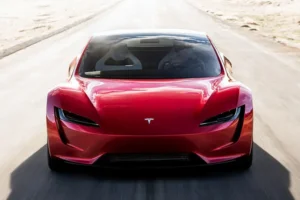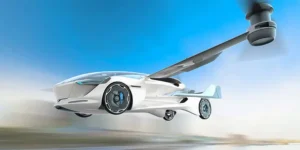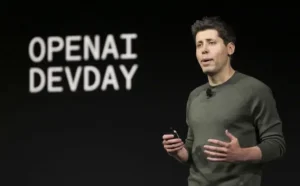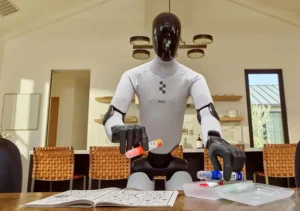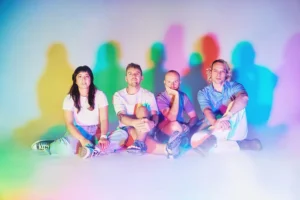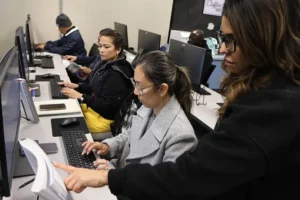The startup Figure has unveiled the third generation of its humanoid robot — now wrapped in soft fabric “skin,” able to feel touch, and equipped with skills that once belonged to science fiction. The future isn’t coming — it’s already here.
The Line Between Human and Machine Is Blurring
Every time we hear the word robot, we imagine cold metal, rigid movements, predictable mechanics.
But what if a robot could feel? What if it could stroke fabric, sense the weight of a banana, or wipe away a drop of water?
The California-based startup Figure is challenging our entire understanding of what a “machine,” “artificial intelligence,” or “assistant” can be.
With its third-generation humanoid, the company isn’t just building a robot — it’s giving technology a hint of humanity.

Soft Skin and Sensors: A New Sense of Touch
One of the most striking innovations of the new model is its skin: a soft, elastic fabric surface covered with tactile sensors.
- The robot can sense touch — a light tap, the tickle of a feather, the cool surface of a tile.
- The sensors respond not only to pressure but also to temperature — distinguishing a warm cup from a cold window.
- Thanks to feedback loops, it can adjust its strength — not crushing fruit, not breaking a cup.
This isn’t just simulated sensitivity — it creates a sense of presence, of trust, of genuine interaction, where it’s hard to tell where the machine ends and the companion begins.
The Robotic Butler: From Dishes to Dinner
Physical dexterity is only part of the story. What truly matters is what this robot can do in a home.
- Dishwashing: Not just splashing water — it sorts dishes, measures detergent, rinses and dries them carefully.
- Laundry: Separates colors, chooses washing modes, and even handles light ironing.
- Cooking: Follows recipes, chops, stirs, seasons, and cooks — with precision and consistency.
This is the literal return of the word “assistant.” Not just a “smart home” with voice commands — but a home with hands.

Why California — and Why Now
California has always been the state of innovation, risk, and reinvention.
It’s where startups grow, futurists build, and people want change instead of fearing it.
- Silicon Valley labs, research centers, and universities are pushing humanoid AI from theory into practice.
- Diverse communities — from busy families to aging residents — stand to benefit most from real, physical assistance.
- A high standard of living and a love of quality make Californians ready to invest in technologies that make life easier, safer, and kinder.
So when such a technology appears, the reaction is natural — curiosity, excitement, even a bit of fear. Because this isn’t just another gadget. It’s a potential partner in daily life.
The Tech Behind the Humanity
To make “Become Human” truly humane, Figure had to combine several powerful technologies:
- AI and computer vision to recognize objects — to tell a plate from a cup, a towel from a rag.
- Tactile sensors and haptic feedback to gauge the right pressure — firm enough to grasp, gentle enough to handle.
- Advanced robotic arms and joints for humanlike precision and flexibility.
- Thermal and safety modules to ensure the robot’s surface stays safe to touch — even while cooking or cleaning.
Each of these breakthroughs is impressive on its own. Together, they paint a picture of a future that seemed like science fiction just a decade ago — and is now quietly becoming reality.

Humanity You Can Touch
This new robot isn’t just a “smart assistant.” It’s a bridge between humans and machines.
- When a robot can feel touch, it stops being a tool and becomes a companion.
- When it can help around the house, it gives people back time, energy, and space to create, rest, and connect.
- When such assistance becomes possible, “help” itself takes on a new meaning — not an obligation, but a choice.
Ethics and Emotions: Questions That Arrive With Progress
With such innovation come serious — and necessary — questions:
- What does privacy mean when a machine can sense touch and see what’s happening at home?
- Who is responsible if a robot breaks a glass or causes harm?
- And are we psychologically ready to accept that a machine can feel?
The good news is that these questions aren’t driven by fear anymore — but by curiosity.
It means that society and technology are evolving together.
Looking Ahead: The Next Frontier
Here are just a few scenarios that no longer sound like fantasy:
- Home assistants that support elderly people — lifting objects, reminding them to take medicine, and providing companionship.
- Kitchen robots that adapt to dietary needs, allergies, and family preferences.
- Service robots in hospitals, hotels, and care centers — capable of comfort as much as precision.
- Integrated smart homes where robots anticipate needs: turning off lights, checking the stove, or adjusting water temperature.

Why It Matters — For Everyone
- Life becomes simpler. No need to spend mornings cleaning or evenings doing laundry.
- There’s more time for family, creativity, and rest — the things that make us human.
- For people with disabilities, this could mean independence.
- For parents, it means less stress and more help.
- For society, it means fewer wasted resources, fewer mistakes, and more innovation and jobs.
When Sci-Fi Walks Into Your Living Room
“Become Human” isn’t just a marketing slogan. It’s a declaration of a new reality — one where humans and machines live side by side, not as rivals, but as partners.
When Figure first revealed its robot, many saw a strange mix of man and machine.
Now it’s clear: this “human inside the machine” isn’t here to scare us — but to support us.
*****
California has always been the first to greet the future — from electric cars to digital revolutions.
Today, it’s meeting its newest arrival: a robot that can feel.
This isn’t a movie plot anymore — it’s the start of a new chapter, where technology finally becomes a mirror of humanity.

